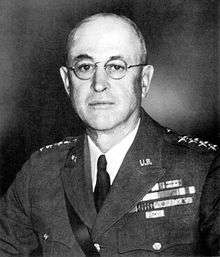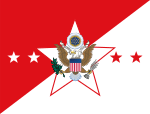Malin Craig
| Malin Craig | |
|---|---|
 Craig as Chief of Staff of the United States Army | |
| Born |
August 5, 1875 Saint Joseph, Missouri |
| Died |
July 25, 1945 (aged 69) Walter Reed Hospital, Washington, D.C. |
| Buried | Arlington National Cemetery |
| Allegiance | United States |
| Service/ | United States Army |
| Years of service |
1898–1939 1941–1945 |
| Rank | General |
| Commands held |
Chief of Staff of the United States Army United States Army War College Panama Canal Zone United States Army Cavalry School |
| Battles/wars |
Spanish–American War |
| Awards | Army Distinguished Service Medal (3) |
Malin Craig (August 5, 1875 – July 25, 1945) was a general in the United States Army who served as the 14th Chief of Staff of the United States Army from 1935 to 1939. He was recalled to active duty during World War II.[1]
Early life
Craig was born on August 5, 1875 in Saint Joseph, Missouri. He entered the United States Military Academy at West Point, New York on June 20, 1894, where he was a classmate of future generals Fox Conner and Guy V. Henry, Jr..[2]
Early career
Craig graduated from West Point on April 26, 1898 and was commissioned as a second lieutenant in the Infantry branch, assigned to the 4th Infantry Regiment. He transferred to the Cavalry on June 23 and served with the 6th Cavalry Regiment in the Santiago Campaign, the United States invasion of Cuba during the Spanish–American War.[2] After his return from Cuba, Craig transferred to the 4th Cavalry Regiment, serving in Wyoming and Oklahoma until 1900, when he served in the China Relief Expedition and in the Philippine Insurrection until 1902. He was promoted to first lieutenant on February 2, 1901,[2] transferring back to the 6th Cavalry.[3]
Craig attended the Infantry and Cavalry School from 1903 to 1904 and the Staff College from 1904 to 1905. He was promoted to captain on May 7, 1904,[2] assigned to the 10th Cavalry Regiment and later the 1st Cavalry Regiment. Craig was garrisoned as a regimental quartermaster at Fort Clark in Kinney, Texas from 1906 to 1909. He would go on to graduate from the Army War College in 1910 and serve in a variety of administrative positions, most notable of which was assigning troops to their regiments. He would then serve with the 1st Cavalry Regiment of the western United States in 1912, then became an instructor at Fort Leavenworth located in Leavenworth, Kansas in 1916 until 1917, when he was moved to the General Staff Corps.[4]
World War I
Craig was promoted to major on May 15, 1917, shortly after the United States entered World War I. He was promoted to temporary lieutenant colonel on August 17 and temporary colonel on March 27, 1918.[5]
Craig served in France during World War I as chief of staff to General Hunter Liggett in the 41st Infantry Division and later in I Corps, where he was promoted to temporary brigadier general on July 11, 1918. He then became chief of staff of the Third Army.[5] He received the Army Distinguished Service Medal for his service during the war. His citation reads as follows:
General Craig served in turn as Chief of Staff of a division, a corps, and an Army, in each of which capacities he exhibited great ability. His personal influence, aggressiveness, and untiring efforts were repeatedly displayed in the operations of the 1st Corps in the vicinity of Chateau-Thierry, on the Oureq, and the Vesle during the St. Mihiel and Argonne-Meuse offensives.[6]
Interwar period
.jpg)
After the war, Craig reverted to his permanent rank of major on August 15, 1919 but was promoted to colonel on July 1, 1920 and to brigadier general only 15 days later.
When Craig was promoted to colonel, he was put in command of the District of Arizona in 1920 and became the commandant of the Cavalry School from 1921 to 1923, after his promotion to brigadier general in April 1921.[4] He served as Chief of Cavalry with the rank of major general from July 24, 1924 to March 20, 1926.[5] He was succeeded by Herbert B. Crosby, after which he was assigned to command the Panama Canal Zone.
Chief of Staff

Craig served as president of the Army War College in 1935, before being selected as Chief of Staff of the United States Army. He served as Chief of Staff from October 2, 1935 to August 31, 1939, succeeding General Douglas MacArthur and preceding George C. Marshall. That appointment carried with it a temporary promotion to full (four star) general.[5]
As Chief of Staff of the Army, Craig pointed out to Congress the army's lack of preparedness in manpower and material, stressed the necessity of lead time in military preparedness, focused attention on army planning, and, within governmental constraints, prepared the army for World War II. He retired, with the rank of general, on August 31, 1939 after forty-one years of active duty service. Upon his retirement, he received a second Distinguished Service Medal for his service as Army Chief of Staff.
World War II and death
Craig's retirement was short-lived, however. On September 26, 1941, with war on the horizon, he was recalled to active duty to head the War Department's Personnel Board, a body responsible for selecting individuals who were to receive direct commissions in the army. He headed the board in his permanent rank of major general until shortly before his death.
Craig died at the Walter Reed Hospital in Washington, D.C. on July 25, 1945, where he had been ill for the previous year.[1] He was posthumously awarded a third Distinguished Service Medal and was buried in Arlington National Cemetery.[5]
Personal life
Craig married Genevieve Woodruff in April 1901.[3]
Awards
| 1st Row | Army Distinguished Service Medal with two oak leaf clusters | |||||||||||||||
|---|---|---|---|---|---|---|---|---|---|---|---|---|---|---|---|---|
| 2nd Row | Spanish Campaign Medal | China Relief Expedition Medal | Philippine Campaign Medal | Mexican Border Service Medal | ||||||||||||
| 3rd Row | World War I Victory Medal with five battle clasps | Army of Occupation of Germany Medal | American Defense Service Medal | American Campaign Medal | ||||||||||||
| 4th Row | World War II Victory Medal | Companion of the Order of the Bath (United Kingdom) | Commandeur of the Legion of Honor (France) | Croix de guerre 1914–1918 with Palm (France) | ||||||||||||
| 5th Row | Commander of the Order of the Crown (Belgium) | Commander of the Order of the Crown of Italy | Order of Abdon Calderón, 1st Class (Ecuador) | Missouri State Medal of Merit | ||||||||||||
Dates of rank
| No insignia | Cadet, United States Military Academy: June 20, 1894 |
| No pin insignia in 1898 | Second lieutenant, Regular Army: April 26, 1898 |
| First lieutenant, Regular Army: February 2, 1901 | |
| Captain, Regular Army: May 7, 1904 | |
| Major, Regular Army: May 15, 1917 | |
| Lieutenant colonel, National Army: August 17, 1917 (Date of rank August 5, 1917.) | |
| Colonel, National Army: March 27, 1918 (Date of rank February 6, 1918.) | |
| Brigadier general, National Army: July 11, 1918 (Date of rank June 26, 1918.) | |
| Major, Regular Army: August 15, 1919 (Reverted to permanent rank.) | |
| Colonel, Regular Army: July 1, 1920 | |
| Brigadier general, Regular Army: July 16, 1920 (Date of rank July 3, 1920.) | |
| Colonel, Regular Army: March 4, 1921 (Reverted to permanent rank.) | |
| Brigadier general, Regular Army: May 9, 1921 (Date of rank was April 28, 1921.) | |
| Major general, temporary: July 24, 1924 | |
| Major general, Regular Army: March 21, 1926 | |
| General, temporary: October 2, 1935 | |
| General, Retired List: August 31, 1939 | |
| General, Retired on Active Duty: September 26, 1941 (Recalled to active duty.) |
References
- 1 2 "Gen. Craig Is Dead. Ex-Chief Of Staff. Distinguished Army Leader Succumbs in Washington After a Year's Illness. Planned 1918 Battles. Helped Map the Strategy for Our Offensives in France. Enlisted Man's Champion Forty Years a Soldier Had Scholastic Difficulty Served With First Corps Sought Increase in Army". New York Times. July 26, 1945.
- 1 2 3 4 Davis, pp. 85–86
- 1 2 Bell 2013, p. 124.
- 1 2 Tucker, Spencer C., ed. World War II: the definitive encyclopedia and document collection. Santa Barbara, CA: ABC-CLIO, an imprint of ABC-CLIO, LLC, 2016. Web. p. 475
- 1 2 3 4 5 Davis, p. 86
- ↑ "Malin Craig". Military Times Hall of Valor. Retrieved 22 March 2018.
- ↑ Official Register of Commissioned Officers of the United States Army, 1944. pg. 1122.
Bibliography
- Bell, William G. (2013). Commanding generals and chiefs of staff, 1775–2013 : portraits & biographical sketches of the United States Army’s senior officer (PDF). Washington, D.C.: United States Army Center of Military History.
- Davis Jr., Henry Blaine (1998). Generals in Khaki. Raleigh, NC: Pentland Press, Inc. pp. 85–86. ISBN 1571970886. OCLC 40298151.
- Official Register of the United States Army. 1945. The Adjutant General. Washington, D.C. p. 1135.
Further reading
| Wikimedia Commons has media related to Malin Craig. |
- "Craig, Malin". 1999. American National Biography. 5.
| Military offices | ||
|---|---|---|
| Preceded by Douglas MacArthur |
Chief of Staff of the United States Army 1935–1939 |
Succeeded by George C. Marshall |

